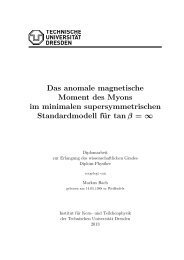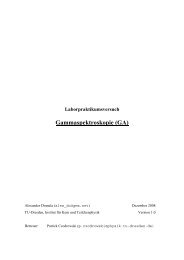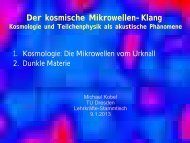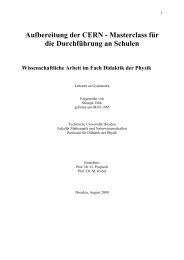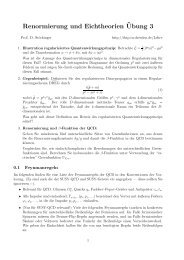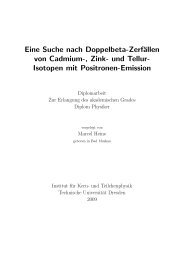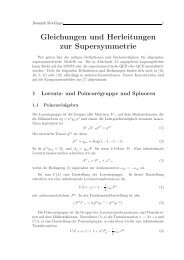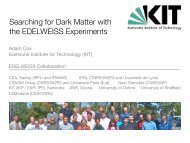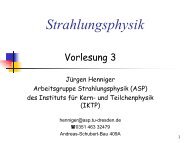a design study for a cobra upgrade to - Institut für Kern- und ...
a design study for a cobra upgrade to - Institut für Kern- und ...
a design study for a cobra upgrade to - Institut für Kern- und ...
Create successful ePaper yourself
Turn your PDF publications into a flip-book with our unique Google optimized e-Paper software.
4.2 Detec<strong>to</strong>r assembly 49<br />
dent pho<strong>to</strong>n of the same energy. The scintillation yield L/E decreases<br />
with increasing particle energy E. This leads <strong>to</strong> more produced scintillation<br />
pho<strong>to</strong>ns <strong>for</strong> Comp<strong>to</strong>n scattered gamma rays than <strong>for</strong> pho<strong>to</strong>ns absorbed<br />
directly by the pho<strong>to</strong> effect. The full energy line width depends<br />
on the contribution of Comp<strong>to</strong>n scattering and the pho<strong>to</strong> effect. It gets<br />
wider the more both processes contribute. With an increasing scintilla<strong>to</strong>r<br />
size the contribution by Comp<strong>to</strong>n effect rises. There<strong>for</strong>e the intrinsic<br />
resolution decreases while the amount of fully absorbed gamma rays<br />
increases. For high count rates scintilla<strong>to</strong>rs of small crystal sizes have<br />
better energy resolution.<br />
The efficiency <strong>for</strong> the collection of scintillation light depends in general<br />
on the scintilla<strong>to</strong>r dimensions, the size and position of the readout device<br />
and the opacity of the crystal. Thus, it also depends on the wave<br />
length of the emission spectrum, the refractive index of the scintilla<strong>to</strong>r,<br />
on the optical coupling, on the refrac<strong>to</strong>r and on the entrance window<br />
of the readout device at these wavelengths. Ultimately, absorption and<br />
loss reduce the detectable scintillation light and worsens the resolution.<br />
Readout devices at opposite sides of the scintilla<strong>to</strong>r increase the<br />
collection efficiency in general and increase the uni<strong>for</strong>mity of the light<br />
collection, leading <strong>to</strong> decreasing variance.<br />
Birks [27] quoted that larger crystals have worse resolution due <strong>to</strong> difficult<br />
uni<strong>for</strong>m light collection. Non-proportional scintilla<strong>to</strong>r response<br />
contributes in the same order of magnitude <strong>to</strong> a decrease in resolution<br />
as nonuni<strong>for</strong>m light collection.<br />
The intrinsic resolution of the readout device is determined by the pho<strong>to</strong>electron<br />
emission efficiency and the electron multiplication process.<br />
The quantum efficiency of the pho<strong>to</strong>cathode limits the amount of produced<br />
pho<strong>to</strong>electrons. It depends on the wavelength of the incident<br />
pho<strong>to</strong>n and on the point of impact. A nonuni<strong>for</strong>mity of the pho<strong>to</strong>cathode<br />
leads only <strong>for</strong> very low count rates <strong>to</strong> a wider line width and does<br />
not contribute otherwise. Thus large diameter PMTs should be avoided<br />
in this case. Finally variations in the multiplication process of the pho<strong>to</strong>electron<br />
in the case of PMT, APD and Si-PMT contribute <strong>to</strong> the resolution.<br />
All readout divices loose resolution due <strong>to</strong> dark current and<br />
PIN diodes especially due <strong>to</strong> electronic noise [27, 30].<br />
For the simulation, described in the next chapter, the energy resolution,<br />
reported by Kim et al. [43], was used. The KIMS Collaboration<br />
used CsI:Tl crystals with surfaces from 55x55 <strong>to</strong> 70x70 mm 2 and 300<br />
mm length. The crystals were wrapped in two 0.2 mm thick Teflon<br />
layers and couplet <strong>to</strong> two three inch PMT’s type D726UK, with RbCs





